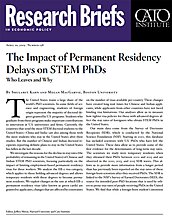The United States trains a large share of the world’s PhD scientists. In some fields of science and engineering, students of foreign origin represent the majority of doctoral degrees granted by U.S. programs. Students who graduate from these programs make important contributions to innovation at U.S. universities and firms. Currently, the countries that send the most STEM doctoral students to the United States—China and India—are also among those with the most students who stay in the United States after their studies. But the number of Chinese and Indian doctoral recipients reporting definite plans to stay in the United States has fallen in the last decade.
We investigate the reasons for the decline in stay rates (the probability of remaining in the United States) of Chinese and Indian STEM PhD scientists, focusing particularly on the impact of limiting employment-based permanent residency visas for these workers. We analyze the EB‑2 visa category, which applies to those holding advanced degrees and allows temporary residents with these degrees to become permanent residents. We exploit changes in the rate at which EB‑2 permanent residency visas (also known as green cards) are granted to applicants, changes that are affected by constraints on the number of visas available per country. These changes have created long wait times for Chinese and Indian applicants, while applicants from other countries have not faced binding visa limitations. Our analyses allow us to measure how tighter visa policies for those with advanced degrees affect the stay rates of foreigners who obtain STEM PhDs in the United States.
Our main data come from the Survey of Doctorate Recipients (SDR), which is conducted by the National Science Foundation (NSF). Starting in 2010, this database has included scientists with U.S. PhDs who have left the United States. These data allow us to provide some of the first evidence for the determinants of long-term stay rates. The scientists we study were temporary residents when they obtained their PhDs between 2001 and 2013 and are observed in the 2010, 2013, and 2015 SDR waves. This allows us to provide more information from a longer period than has previously been reported on the stay rates of these foreign-born scientists after they received PhDs. The SDR is linked to the NSF’s Survey of Earned Doctorates (SED), the source for intended post-PhD locations that is used by others to proxy stay rates of people receiving PhDs in the United States. We find that while a foreign-born student’s intention to stay in the United States (measured at the time of graduation by NSF’s SED) is an important predictor of long-term stay rates, their long-term propensity to stay in the United States exhibits some very different patterns.
Country-based limitations on EB‑2 green cards are associated with reductions of 2.4 percentage points in the stay rates of Chinese students for every year of delay relative to students from the rest of the world, while Indian students are only affected by very long delays in visa processing. Indian students facing delays of five and a half years or more have a relative stay rate that is about 8.9 percentage points lower. This relative reduction in the stay rates of Chinese and Indian students is estimated after controlling for macroeconomic and scientific conditions in the students’ home countries and is robust to controlling for country-specific time trends. These results suggest that the decline in the relative stay rate is explained not by improvements in living and working conditions in China and India but by the effects of immigration policy on the attractiveness of working in the United States.
In addition to measuring the effects of visa availability, we estimate the relationship between stay rates and home countries’ macroeconomics and scientific research bases. Although prior research on stay rates has not typically controlled for the strength of scientific enterprises in the home country, we find that this factor is an important predictor of return rates. Students from countries ranked the lowest in terms of publication output exhibit stay rates that are 13 percent higher than those of students from the highest-ranked countries. The quality of articles produced in the home country (as measured by citations per article) is also a strong predictor of whether foreign-born students return to their home country.
We also examine which fields of study are most affected by this combination of factors. We find that the fields with the greatest apparent excess demand for STEM PhDs are also the fields with the most graduates affected by visa restrictions. Thus, the rapid improvement of scientific activity in foreign-born students’ home countries and limitations on the number of immigrants by country of origin discourage international students from remaining in the host country after graduation, reducing the supply of workers available to be hired by innovative firms in the United States.
NOTE:
This research brief is based on Shulamit Kahn and Megan MacGarvie, “The Impact of Permanent Residency Delays on STEM PhDs: Who Leaves and Why,” NBER Working Paper no. 25175, October 2018, http://www.nber.org/papers/w25175.
About the Authors

This work is licensed under a Creative Commons Attribution-NonCommercial-ShareAlike 4.0 International License.
